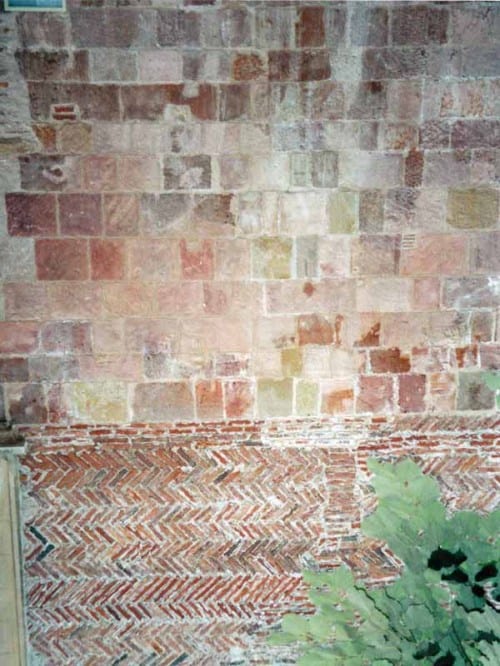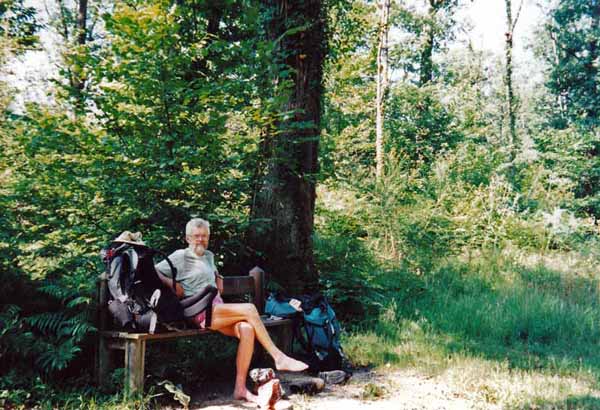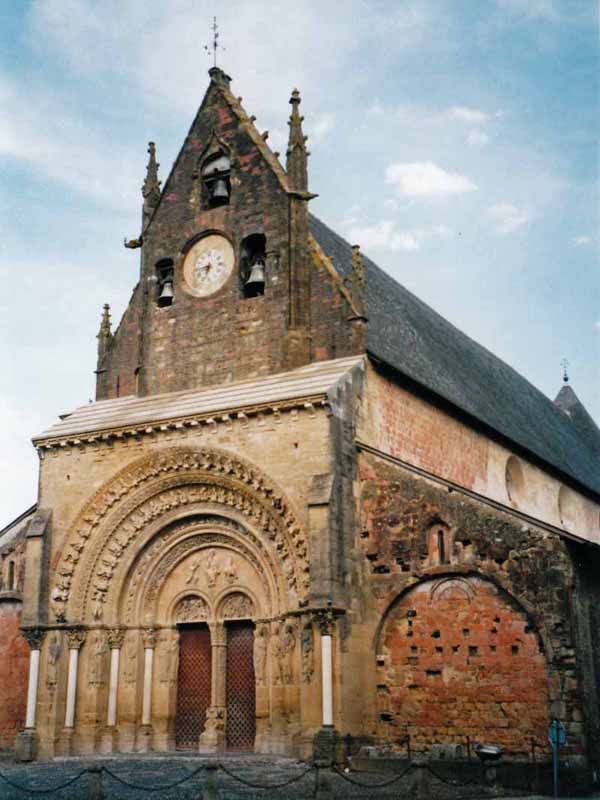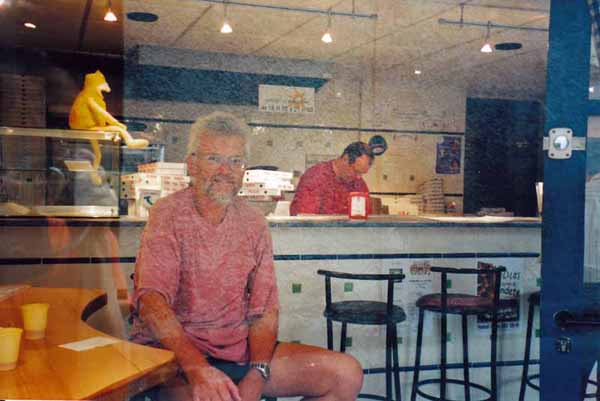Sunday, 29 June 2003
Distance 24 km
Duration 5 hours 20 minutes
Ascent 222 m, descent 100 m
Map 69 of the TOP100 blue series (now superseded)
Topoguide Le Chemin d’Arles (blue cover)

Our plans were changing. The last two days had cured us of long forced marches and we wanted our remaining week to be more of a stroll, with short stages and multiple coffee breaks. The aim was now to get no further than Auch.
Shoving some muesli (not our favourite food) down our throats, we set off at 8 am, feeling lively and optimistic. Half an hour later we were in Lescar itself, grateful that we had not had to do that uphill road-bash at the end of yesterday’s marathon.
There is an ancient church surrounded by cottages at the top of the rise, with a fine expansive view, but it was hazy as usual, even though the sun was bright. A faint irregular blue line was all we could make out of the Pyrenees.
The local population is used to seeing pilgrims walking through, but not in the direction we were going. A well-meaning woman leaning out of a high window almost insisted that we turn around, until I finally convinced her that we actually wanted to go the wrong way.
Leaving town on a tiny road, we soon realised that we were once again following erased GR signs, our map being hopelessly out of date. This was a slight worry, but before long a car drew up beside us and a man jumped out, eager to help.
He, like many Frenchmen, had done parts of the pilgrimage himself, and his sister was presently on the Way du Puy. People generally are very sympathetic to walkers and often toot their horns and wave if you are on a road. Our benefactor said that we were off the track but not lost and would soon be on “la bonne route” again. Slapping us warmly on the shoulder, he leapt back in his car and vanished.
The path left the road and became a pleasant country lane, although we were on the edge of suburban Pau. Here we met three pilgrims coming from Morlaàs, the only fellow walkers we had seen since leaving Saint-Engrace. We had a delightful chat, exchanging useful information about the way ahead.

Pressing on, we came to a main road with a hotel on the corner, but the stone-faced vigilante on the door sent us away to the bar down the street, which turned out to be closed.
Looking back, we should have persevered and found ourselves another bar in the streets nearby, but we hoped that we would find one along the way.
The next thing we came to, amazingly, was the Cami Salié, the very same salt-trading road that we had trodden near Arthez-de-Béarn so long ago. The difference was that this bit was tarred and kerbed and full of traffic.
Past the Hippodrome, we branched off over the autoroute and entered a wood, which was busy with Sunday morning activity. Runners, promenaders, dog-owners and pram-pushers were thick on the path. A couple stopped to make sure we were not going to get lost. I was flagging already, so we had a rest and a snack on a shady bench.
As we emerged from the wood, looking for a GR sign, we met a man and a woman strolling hand in hand. He wore a primrose-yellow Lacoste outfit (indeed he probably was René Lacoste, he looked rich enough) and his consort was a dark beauty, now lined with age. He wanted to practise his English, which was fluent enough but wonderfully comical to listen to. He told us that this bit of the GR had been rerouted and we had to go another way. He was right and we soon found the signs again.

After a stretch of beautiful farmland and woodland, we stopped in the shade beside a canal for our simple lunch. It was fiercely hot in the sun by now and we were running out of water, a state of affairs that we blamed on the deplorable lack of bars in these parts. I picked an unripe apple and nibbled it to disguise my thirst.
A long ascent on a stony path flanked by shrubbery brought us to a bitumen road and from there we descended steeply into Morlaàs. Looking forward to a big cold drink of water and a coffee, we hurried through the unpeopled streets, following a sign to “Bar-Hotel”, and arrived at a vast dusty square. The hotel was there but it was closed.
In desperation I pushed the door and it fell open under my hand. Inside, it was like the Marie Celeste. We called out but nobody came. Carafes of water, half-drained, were piled up on the counter, so we finished off a couple of them and poured some more into our bottles. Out in the empty wasteland again, we met a lone man who told us where the camping ground was, not far away next to the town swimming pool.
Both the pool and the camping ground were deserted. Nevertheless, we went in, had showers and lay down for an exhausted sleep. I felt I was running out of reserves, both physical and emotional, although it could have been just caffeine I was low on. We had had none all day. It was a lesson in what a French village can be like on a Sunday afternoon, but at the time we did not understand this. We condemned Morlaàs as a graveyard that we never wanted to see again.
Eventually the pool opened and kids began arriving. Soon there was an excited hubbub, the same in pools all over the world, which was a cheerful sound. Families came to play tennis near our tent, seemingly impervious to the heat. A few other campers appeared from their caravans, including a shockingly fat woman with bare breasts dangling. Keith said it was a man but I was scandalised anyway.

In the evening, still hot, we walked back hoping to find the town had woken up, but apart from a few old men playing petanque in the square, there was still no sign of life. Just as we were resigning ourselves to muesli for dinner we came to a take-away pizza bar.
The beaming man invited us to eat at his little side table. Not only that, but he also sold wine, so we selected a cold rosé and he kept it in the fridge between refills of our yellow plastic cups.
He trained his fan in our direction while we tucked into the house speciality – le Chat Botté, with Roquefort cheese. We had two family sized pizzas and the whole bottle of wine and were blissfully happy. We are easily cheered up. When we left, Keith shook our saviour’s hand with real affection.
On the way back to the tent we were able to appreciate the beauty of the church. Morlaàs was the capital of Béarn in the eleventh and twefth centuries, succeeding from Lescar (before Pau even existed), which explains why both places have such elaborate old churches. The one at Morlaàs has the rustic appeal of a patchwork quilt, with all its repairs and extensions.
Previous day: Oloron-Ste-Marie to Lescar